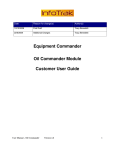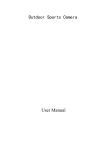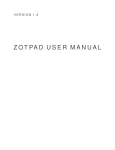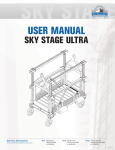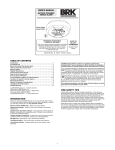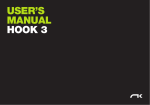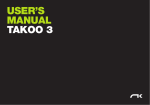Download Public review form
Transcript
Draft resolutions to public review responses BSR E1.43 - 201x, Performer Flying Systems PLASA North America Referenced document: BSR E1.43-201X, Entertainment Technology - Performer Flying Systems (Document number Rig/2013-2039r9) ANSI public review period: 14 August 2015 through 28 September 2015 Question: Do you recommend that the standards committee accept BSR E1.43-201X, Entertainment Technology - Performer Flying Systems (Document number Rig/2013-2039r9), as an American National Standard, that its requirements are not too lax, too onerous, or too vague, nor that it would unreasonably negatively impact materially affected parties in the entertainment industry? Please indicate "Yes" (accept it), "Yes with comments," or "No with reasons" (don't accept it). Responses: Name Tracy Nunnally Adam Yeager Gary Mardling Jem Hodgson Representing Hall Associates Flying Effects (HA) Tait Towers (TT) Kish Rigging (KR) Cirque du Soleil (CDS) Yes Yes with comments No with reasons X X X (Comments submitted, sorted by clause) # Commen Clause Comment ter 1 HA 1 Page 1: Paragraph about 2/3 of the way down, starting with "Flexible media onto which..." • Should the scope of this sentence be opened up to include rigid media like lyra, trapeze, etc.? or does the standard cover those things? 2 KR 2.6 2.6 Category 0 stop “...immediate removal of power to the machine actuators.” Comments only X Proposed response Reject. The sentence specifically excludes this special use of flexible media on which a person actively engages their bodies. There is another bullet point excluding any connection that ultimately relies on the strength or ability of the flying performer. The standards covers the strength of lyras, which are essentially ride-on props, but it excludes the physical connection of the performer’s body, which is not typically done with a harness. Accept. This editorial change will be made. Rig/2015-2029 # Commen ter Clause Comment Proposed response Suggested change: ...immediate removal of power from the actuators 3 CDS 2.7 Reason: consistent use of “from” and “to”. e.g. In 2.7 “...power is removed from the machine actuators...” The following suggested replacement improves clarity 2.7 Category 1 stop: A controlled stop with power to the machine actuators available to achieve the stop, then when the stop is achieved, or after a timeout occurs, power is removed from the machine actuators. 4 KR 2.24 5 HA 2.47 6 KR 2.47 7 KR 3.6 2.24 load path “..directly support the flying performer to the lifting medium...” I was unclear about the intent of this sentence, because the words as written are combined in an unusual way. Possibly: ...support the flying performer from the lifting medium... or ...connect the flying performer to the lifting medium... Section 2.47: tensioned cable track • This doesn't seem to apply to our cable track systems from what I can tell. Is it worth mentioning it to them or would we rather keep that method to ourselves? • (There is a section on Page 16 that discusses tensioned cable tracks further.) Our systems are dynamically tensioned using a counterweight. I understand the spirit of the definition, but does a cable track that has essentially no change in tension qualify as "statically suspended"? 2.47 tensioned cable track Perhaps an annex note/drawing could be made to illustrate this. I was thrown off by the combination of “curved” and “catenary”, because I think (incorrectly) of a curved track as being curved in the plane which is parallel to the floor. After some thought I understood what was being said, and it may well be that most people would have no difficulty with this. 3.6 typo “...multiple Flying Operators with coordinated function.” Reject. The current definition of Category 1 is consistent with the standard industry definitions: NFPA 79, IEC 60204-1, and E16.1. When used as part of a safety function, timeout conditions could be employed by the flying system designer based on RA/RR. Accept. This editorial change will be made as follows: “…Portions of the ride-on prop that directly connect the flying performer to the lifting medium…” Reject. The system described by the Commenter is a custom rigging system that differs from the defined tensioned cable track in the draft standard. Accept in Principle, The word “curved” will be omitted from the definition. Accept. This editorial change will be made. Rig/2015-2029 # Commen ter Clause 8 KR 3.8 9 KR 3.9 10 HA 3.14 11 CDS 4.2 12 CDS 4.2 Comment should be “functions” 3.8 Flying Safety Supervisor While I delight in the correct spelling of “queuing” it seems to be inconsistent with the other spelling used throughout this document, and (sadly) should probably be changed. 3.9 Flying Supervisor typo “wellbeing” should be hyphenated Spotter: Competent person responsible for: Proposed response Accept. This editorial change will be made to correct the spelling of the word “cueing.” Accept. This editorial change will be made. Reject. Section 3.1 Intent and the Annex note HA proofreader comment: Are all of these duties required from each Spotter? clearly state that the categories are not I'm thinking in particular of an actor onstage hooking someone in, but not necessarily job titles, but are roles and necessarily being responsible for placing the harness on the performer, etc. responsibilities of participants in the performer flying system. A person may take Tracy Nunnally comment: I see her point here. It might be worth mentioning in on multiple roles depending on the nature of the flying effect. From the lengthy the annex note that specific roles can be assigned to individuals who are explanations, it is clear that Spotter roles properly trained by the competent person, or something to that effect. can be taken on by any number of people as needed for a given flying effect. The following suggested replacement includes other persons at risk. Reject. This requirement of Section 4.2.7.3 specifically pertains to end-of-travel 4.2.(?) End stops for traveler track protection for the person(s) on the flying rig. A risk assessment shall be conducted to assess end of travel protection for the The requirement to protect members of the public and other show personnel from Flying Performer, other production personnel and audience members. unintended contact associated with performer flying is covered in Section 4.2.8.6. The following suggested replacements includes a slack rope condition, and allowance for a purely vertical flying effect e.g. without any intended pendulum swings. 4.2.(?) Flying System Design Details Accept first part. The first clause will change to: “4.2.8.3 Sheave blocks and drums shall be designed or selected as to prevent the lifting medium from coming out of the groove under all loading conditions.” Sheave blocks and drums shall be designed or selected as to prevent the lifting Reject second part. medium from coming out of the groove under all loading conditions. With the current language, it is understood that pendulum swings pertain to those Rig/2015-2029 # Commen ter Clause 13 HA 4.2.2.6 14 CDS 4.3.4 Comment Proposed response The performer flying system design shall accommodate all anticipated pendulum swings without exceeding fleet angle specifications. relevant to the flying act. “4.2.8.5 The performer flying system design shall accommodate pendulum swings without exceeding fleet angle specifications.” Reject. This situation is covered by Clause 4.2.6.6: “Where the performer flying system is attached to rigging equipment deemed “Not suitable for flying people” by the manufacturer, the Flying System Designer shall use RA/RR to determine appropriate use and takes on full responsibility for this use.” Reject. This comment pertains to 4.3.2.7. Identification of hazards associated with use includes those associated with rescue procedures. Maybe I am just sleep deprived, but I cannot seem to find the section that allows the use of a batten if the competent person determines that it is appropriate for the load, even if the batten manufacturer has a blanket statement that it does not. The following includes the hazards associated with rescue procedures 4.3.4 Analysis 15 CDS 4.5 A written risk assessment shall be made available by request. The report shall contain details describing: Definitions of the limits of use Identification of the hazards associated with use Identification of the hazards associated with rescue procedures Identification of hazards associated with reasonably foreseeable misuse Classification of the risk in terms of severity and probability of harm Methods used to mitigate the risks Date of completion The following includes tests under harness documentation 4.5 Personal flying equipment Harnesses 16 CDS 4.5 Harness Manufacturer shall provide the following: Inspection and Test criteria Factory Quality Control Documentation User Manual The following includes the possibility of an independent hoisting system to provide a secondary safety means for a performer riding in a ride-on prop. Reject. This comment pertains to 4.5.1.5. This clause identifies information to be furnished by the harness manufacturer. Testing of the harness prior to sale leaving the manufacturer is covered by factory quality control. Testing of the harness when used as part of the performer flying system is covered in Sections 5, 6 and 7. Reject. An independent, alternative load path is permissible based on RA/RR. Rig/2015-2029 # Commen ter Clause Comment Proposed response Ride-on props 17 HA 4.5 18 HA 4.7 19 HA 4.7 20 CDS 4.8 Any flying vessels, platforms, or props shall be designed by a qualified person. Ride-on props shall be designed to comply with Section 4.3.3 Loading Conditions. Ride-on props shall be attached in a manner that in the event of a failure of the prop support lines the prop does not become supported by the Flying Performer, the Flying Performer's harness, or any point along the load path to the Flying Performer. All Flying Performers riding on or in flying vessels, platforms, or props shall be tethered directly to the load path, or utilize an independent, alternate load path. Personal Flying Equipment / Ride-on Props reads "Ride-on props shall be attached in a manner that in the event of a failure of the prop support lines the prop does not become supported by the Flying Performer, the Flying Performer’s harness, or any point along the load path to the Flying Performer." Reject. The Task Group recommends no change to Sections 4.5 and 4.6. We believe that the provisions in the draft standard define the default approach that should be taken. The HA flying directors' comment: In some cases, it is safer to have the performer's process of RA/RR allows the Flying System harness system directly in the load path of the ride-on prop. For example, flying Designer to alter specific provisions of the Miss Gultch on her bicycle for the Wizard of Oz. Suspending the bicycle and standard for special situations such as the then placing the performer on it creates a top heavy rig that makes it impossible one described by the Commenter. for the performer to balance. Connecting the flying wire to the performer's back and the frame under the seat to her hips creates a comfortable and safe rig. Performer's weigh and bicycle weight are combined for the total load. Does the qualifier "in the event of a failure of the prop support lines" exempt a case like this? Also, should there be commas around "in the event of a failure of the prop support lines"? HA proofreader comment: The word "correspond" should be replaced with Accept. "corresponds". This editorial change to 4.7.2 will be made. Tracy Nunnally comment: Yup. What about gear that we purchase that isn't stamped? Sweeney shackles? Bolts? etc. I assume this is covered by "grade rating"? The following change would require peak loads to be documented by empirical testing in addition to characteristic loads, before being able to reduce the WLL design factor. Reject. The clause allows for non-stamped hardware as long as it is supplied with appropriate documentation. Reject. This comment pertains to 4.8.4.1. The intent of this sentence is to allow relief for the engineering designer in situations where Rig/2015-2029 # Commen ter Clause Comment Proposed response 10X WLL is deemed overly-conservative relative to the 6X characteristic load, when there is ample confidence in the Flexible lifting medium Flexible lifting medium (e.g., rope, chain, band, webbing) shall be designed with characteristic load. This relationship is not a minimum design factor of 10X WLL, 6X characteristic load and 3X peak load. relevant to peak loads. In situations where the characteristic loads and peak loads are confirmed by documented empirical testing data or by engineering calculations prepared by a qualified person, the Flying System Designer is permitted to reduce the WLL design factor to 8X. Missing word - "in" Accept. This editorial change to 4.8.8 will be made. Diameter and quantity of sheaves and rollers In the case of flexible lifting medium, the quantity and relative position of the sheaves and rollers in the performer flying system shall be used to determine the number of bending fatigue cycles on the lifting medium during each operation. The number of bending fatigue cycles, the number of changes in bend direction, and the D/d ratios shall be considered when determining the effective service life. 4.8 Lifting medium Accept. Editorial change will be made to use only I started thinking about whether it should be “media” when the subject got to the word “medium.” “...when multiple lifting medium are used...” “Medium” and “are” being the pair of words which triggered my concern. I do accept that this is probably a cumbersome can of worms, because looking back in this section there are places where either word could be appropriate, but I wanted to increase your awareness of this possible issue. 4.8 Lifting Medium 21 CDS 4.8 22 KR 4.8 Diameter and quantity of sheaves and rollers “In the case of flexible lifting medium...” I would suggest that this should say: In the case of a flexible lifting medium... or In the case of flexible lifting media... 23 KR 4.8 Probably the former is better, because later in the paragraph, reference is made to “the medium”. 4.8 Lifting medium Accept. Rig/2015-2029 # Commen ter Clause Comment Proposed response This editorial change to 4.8.11 will be made. 24 25 26 CDS CDS CDS 4.9 4.10 4.10 Wear or abrasion points typo D;d instead of D:d Add equipment longevity due to deflection. Reject. Stress is related to equipment longevity, not deflection. 4.9 Static Load Bearing Components (See Annex note.) Strength Deflection of all static load bearing components shall not be detrimental to equipment operation or equipment longevity. Allow the inclusion of hydraulic, pneumatic, counterweighted or other actuators. Reject. The terminology is consistent with the title of the Section. 4.10 Electromechanical Actuation Mechanical If an electromechanical actuator is selected that is capable of producing a force that would overload any of the elements in the load path based on the required design factor, then the Flying System Designer shall incorporate measures to reduce the maximum force from the actuator on the components in the load path so that the required design factors are satisfied. Change device to devices to ensure all brakes are applied, as the failure of the Accept in Principle. belt may exclude braking from one of the devices. This comment pertains to 4.10.2.5. The clause will be changed to: “4.10.2.5 For machines where the drum or other For machines where the drum or other termination point of the lifting medium is termination point of the lifting medium is driven by a chain, belt or otherwise not driven by a chain, belt or otherwise not directly driven by a gearbox or other directly driven by a gearbox or other prime prime mover, measures shall be taken to ensure that any failure of the drive mover, measures shall be taken to ensure chain (belt, etc.) shall cause all the load securing devices to engage. that any failure of the drive chain (belt, etc.) shall cause the load securing devices to engage.” If the speeds are low enough, and the motors are correctly current limited to Reject. prevent overload - would it not be possible to use Direct On Line motor starting This comment pertains to 4.10.3.2.6. as opposed to variable speed? The Flying System Designer is permitted to modify requirements based on RA/RR. Control functions Load-securing devices 27 CDS 4.10 The delivery of motive force shall be controllable in order to ensure safe flight and safe rescue, unless based on RA/RR, the speeds are slow enough to Rig/2015-2029 # Commen ter Clause 28 CDS 4.10 29 CDS 4.10 Comment allow direct starting and stopping of the actuator(s). Electric motors if used shall have variable speed drives. Hydraulic systems if used shall have proportional valves and pressure relief valves. There seems to be a duplication in the Emergency stop section. We propose Accept in Principle. the following as an alternative. This comment pertains to 4.10.4.2.1 and 4.10.4.2.5. Safety functions The redundant clauses will be combined into one clause: “4.10.4.2.1 The performer Emergency stop flying system shall have an emergency stop The category of emergency stop for each axis of motion shall be either function that stops each axis of motion by Category 1 or Category 0 as determined by the RA/RR, with consideration of implementing either a Category 0 or a effects on the Flying Performer, machinery, and supports. Category 1 stop. The choice of category Performer flying systems shall have an emergency stop function that stops the shall be on the basis of the RA/RR and the functional needs of the performer flying drive system by implementing either a Category 0 or a Category 1 stop. The choice of category shall be on the basis of the RA/RR and the functional needs system, with consideration of effects on the Flying Performer, machinery, and supports.” of the performer flying system, with consideration of effects on the Flying Performer, machinery, and supports. Also, in the Emergency stop section, an emergency stop push may not always generate a "fault" condition - therefore we propose the alternative. It is noted that this is contrary to E1.6-1 which states that an E-Stop must create a "fault" condition. The fault condition created by the initiation of an emergency stop shall only be reset by resetting the emergency stop device followed by a separate unique action by the Flying Operator. 30 HA 4.10 Proposed response Reject. This comment pertains to 4.10.4.2.4. The initiation of an emergency stop creates a fault condition, which is consistent with E1.6-1. Other than removing the word “fault,” the remainder of the proposed change does not modify the meaning of the clause. After the initiation of an Emergency stop, the Emergency stop system shall require an operator's interaction to reset it. Resetting of the emergency stop condition shall not restart the flying system, but only permit restarting by the Flying Operator. Electromechanical Actuation - bottom of page 23 - "Electric motors if used shall Reject. have variable speed drives. Hydraulic systems if used shall have proportional The Task Group recommends no change to valves and pressure relief valves." Clause 4.10.3.2.6. Intended meaning is clear and commas are optional in this type HA flying directors' comment: Should "if used" be bracketed by commas in both of use. sentences? Rig/2015-2029 # 31 Commen ter HA Clause 4.10.3.3.2 Comment Proposed response Here's my draft of the revision to the language about the whole soft limit/joystick Reject. thing. I have provided several suggestions for the new text, followed by my commentary explaining how our systems work and why we are requesting the The Task Group recommends no change to the clause. The current language provides change. Feel free to adjust/edit as needed before sending it up the chain... a suitable and safest default approach to 4.10.3.3.2 (Programmable Control Systems) this issue for use in show. For the specific Original Text: “Soft limits shall be functional in both joystick and run-cue situation described by the commenter, the operational modes.” Flying System Designer is allowed to alter specific provisions of the standard based on RA/RR. Proposed new text (Multiple versions): 1. “Soft limits shall be functional in both joystick and run-cue operational modes, unless an additional hardware limit is used to limit joystick The following will be added to the Annex: speeds as it approaches the normal limit” “A4.10.3.3.2 Joystick operation of a system 2. “Soft limits shall be functional in both computer joystick and run-cue in "local" mode, i.e., operation in the operational modes. absence of a functional programmable 3. "Soft limits shall be functional in both joystick and run-cue operational control system, might not require functional modes, except when the joystick control exists as a separate, "soft" limits" based on RA/RR.” redundant means of control." 4. Soft limits shall be functional in both joystick and run-cue operational modes except as noted in *new clause*” a. *New Clause* “In systems where joystick control is a redundant means of control, separate from any programmable control system, soft limits are not required in joystick mode, provided that an additional hardware limit is used to slow the system down to a reduced speed prior to reaching the normal limit. Commentary: On our winches the joystick operation is deliberately kept separate from the computer controls. This allows the joystick to completely bypass/override computer control by interfacing to the drive directly. In the event of a malfunction of the computer, or of the network interface between the computer and the winch, the joystick remains a viable option to either get the performer down from the system, or manually run a flight sequence, possibly eliminating the need to interrupt or cancel a performance. To prevent the system from hitting the normal limit at a high rate of speed which could cause an over-travel scenario, we employ an additional deceleration “decel” limit. Our system is designed so that when the decel limit is tripped it immediately limits the maximum speed from the joystick to ¼ (or less) of machine maximum speed (Basically, it takes the analog speed signal from the joystick and reduces it by 75%). In practice, this means that when approaching the limits on our system while using joystick control mode, the first limit tripped is the decel, which Rig/2015-2029 # Commen ter Clause Comment Proposed response causes the system to operate at a limited speed in that direction. Then, the normal limit, if tripped, is tripped at the limited speed, which prevents an overtravel condition from occurring.g. 32 HA 4.11 Our objection to implementing the soft limits in the joystick mode is that in the event of a computer malfunction, it is possible that the soft limits could falsely trip, thereby preventing the use of our joystick system as an alternative or override control method. Paragraph 3, starting with "If a load rating document..." Who decides who is the "facility's technical representative" that is capable of signing off on the space? Do we need to get their 'sign off' in writing? Ahead of time? It is rare that we have a "facility technical representative" who understands loads and forces, and in a lot of cases the tech rep is a gym teacher that builds sets. The standard does not address this. 33 CDS 4.12 34 HA 5.3 35 TT 5.6 Include confirmation of structural adequacy of the facility as well as the flying system during installation and erection. Reject. The facility must be responsible for its facility structure. It is not the intent of this standard to stipulate how facility management operated, only that the facility has to be responsible for its building. An objective of this standard to is help dispel confusion over such responsibilities in hopes of improving accountability. Reject. Engineering related to installation and erection insofar as the facility structure are concerned is addressed in Section 4.11 Facility Anchorage. 4.12 Engineering related to system installation and erection The structural adequacy of the Performer flying system, and the facility structure, during erection and installation shall be evaluated, including limitations imposed by weather. HA proofreader comment: There should be a period at the end of this sentence. Accept. This editorial change to 5.3 will be made. Tracy Nunnally comment: Yup. My comment relates to Factory Acceptance Testing: Reject. Section 5.6 requires cat-0 testing at full speed traveling up and down. This represents a very severe load that is expected to occur very rarely throughout the service life of a winch. I am concerned that by requiring cat-0 testing whenever a winch is sent out, particularly whenever a winch is re-used (as required via section 5.10) we could be dealing unnecessary cumulative damage to the machine. We debate this a lot here at TAIT, and my position is usually that it is important to demonstrate that the machine can withstand cat-0 stops without being damaged. However, this can be shown just once when the machine is built, or when it is modified, or if we have another compelling reason to do so. For certifying a stock winch for a new show, I think that static brake Section 4.10.4.2.1 Emergency Stop states: “The category of emergency stop for each axis of motion shall be either Category 1 or Category 0 as determined by the RA/RR, with consideration of effects on the Flying Performer, machinery, and supports.” Section 5.6.10 requires full speed/payload emergency stop testing in the shop, which could be either Category 0 or 1 as determined by the Flying System Designer. Rig/2015-2029 # Commen ter Clause Comment Proposed response testing and/or brake pull through testing provides enough information to make sure that the brakes can safely stop and hold the required loading, and if we determine it is necessary we can use pull through testing to provide additional information to calculate shock loads on performers and equipment. An E-stop is an anticipated event from which the system must be able to safely accommodate however often it occurs. If we cat-0 every time we send a winch out on the road, we could be shock loading a winch several dozens of times more than it would ever be expected to withstand in service. Perhaps in this section some language could be added that reassures designers that we have freedom to develop responsible testing procedures as long as we can back up our decisions in a reasonable way. The standard does a good job at this in other areas. 36 HA 5.7 37 HA 5.7 The RWG notes a similar situation that might concern the commenter, which happens during site commissioning testing in section 6.5.3.4.4, which states: “Power loss proof load test: WLL with Category 0 stop, full speed in both directions. Distances travelled after initiation of stop shall be recorded and included with SAT documentation.” The RWG feels that this worst case scenario deserves testing during commissioning in order to ensure safety under worst case loading. Note that Section 6.5.1 allows relief for a touring production as follows: “Commissioning testing procedures shall be determined by the Flying System Designer and System Supplier. In situations in which a performer flying system is touring, modified testing protocols may be performed on subsequent uses after commissioning first use, as determined by a qualified person based on RA/RR.” Identification - "Critical components, as outlined by the Flying System Designer, Reject. shall have a serial number or some other unique identifier." The RWG feels this sentence clearly states that critical components are identified by the HA flying directors' comment: Does this mean that the FSD decides what is a flying system designer. critical component and then it shall have a number? Or does it mean that the FSD decides which critical components should have a number? I am a FSD, and I consider a 3/8" shackle a critical component, but I do not think that each of my 900 3/8" shackles each need to be identified and tracked. Can we make the statement clearer? Identification: Second sentence Reject. The word “permitted” allows any of the HA proofreader comment: The choice of the word "permitted" makes it sound parties listed to affix an identifier to the like it isn't required to affix an identifier, but the spirit of the paragraph seems to component. The following change will be Rig/2015-2029 # Commen ter Clause Comment Proposed response imply that one is required. Is this a language change that should be made so people don't think they don't have to do it? Or is this intentionally left open? 38 HA 5.8 39 KR 5.8 40 HA 6.5 41 HA 7.9.3 made to this clause, pursuant to Comment No. 14 below: “The Flying System Designer shall outline which flying system components are critical. Critical Tracy Nunnally comment: She has a point here. components shall have a serial number or some other unique identifier. If the critical component is not furnished with a serial number from the manufacturer, then the System Supplier, Installer, or User is permitted to affix an identifier to the component.” HA proofreader comment: There should be an apostrophe in component's. Accept. This editorial change to 5.8.4.1 will be Tracy Nunnally comment: Yup made. 5.8 Documentation Accept in Principle. General Requirements 5.8.1.2 will be revised as follows: “... covering operations and maintenance of the system, or exist electronically...” “The System Supplier shall furnish a system manual or manuals, covering operations Probably missing words, and should be: and maintenance of the system, or they shall exist electronically such as in PDF ...covering operations and maintenance of the system, or they should exist format.” electronically... Third new paragraph, starting with "Load tests shall be conducted..." Reject. The Task Group recommends no change to HA proofreader comment: Does this mean we need to ship a weight to every Clause 6.5.3.1. For the specific situation gig now? described by the Commenter, the Flying System Designer is always allowed to alter Tracy Nunnally comment: We do not do this for manual systems that have clear specific provisions of the standard based on flight paths and simple installations. If there are questionable anchorages, RA/RR. possible obstructions, or any questionable movements of system components, we always use a test weight. We also always use a test weight for motorized systems. Question about the Rescue team, including the Incident Commander, Rescue Reject. Rigger, and First Aid Attendant,. If we are flying in a high school or a church, on The Task Group recommends no change to a manual system where there is simply no way for a person to become stranded Clause 7.9.3. The RWG feels it is prudent in the air, does the church or school have to provide someone first aid trained to to have personnel trained in first aid be there for all flying? I can completely understand the need for this in the case whenever flight occurs, regardless of the of a motorized system where a person could become stranded, but I am specifics. The Flying Safety Supervisor struggling with it on the small simple shows shall determine the level of first aid training Rig/2015-2029 # 42 Commen ter KR Clause 9.4 Comment Proposed response 9.4 End of service life “Any equipment that has exceeded its lifespan as defined...” needed, even if it is simply general first aid and CPR training at a bare minimum. Reject. The RWG believes that having met lifespan does not technically constitute exceeding lifespan. Suggest: “Any equipment that has met or exceeded its lifespan as defined...” 43 CDS Annex Reason: To include the time when the item has expired, and not just the time after that hurdle has been cleared. A couple of clarifying notes for the appendix. The proposed definition for a "regular basis" is for up for discussion Accept. The Annex clause will change to: “A4.2.8.4 Proper sizing of grooves in sheaves and drums should typically follow the lifting medium manufacturer's recommendations and machining standards. Deviations may be permissible if determined by the Flying System Designer using RA/RR, with consideration the lifting medium material and type, cycles, anticipated wear, maximum loads, and maximum operating speed and accelerations.“ A4.2.10.1.6 Open end terminations include hooks without spring latches. As per Accept. The Annex clause will change to: Section 4.6 Quick-Connect Hardware, any device that opens is opened on a regular basis (once or more per performance, rehearsal or maintenance) shall have a redundant means of actuating that open movement. Use of hooks “A4.2.10.1.6 Open end terminations include hooks without spring latches. As per with spring latches or "gates" (for example on chain motors) should be evaluated as part of the RA/RR process and special attention should be paid to Section 4.6 Quick-Connect Hardware, any device that is opened on a regular basis potential for slack conditions that may negate any protection the spring latch (once or more per performance, rehearsal provides. or maintenance) shall have a redundant means of actuating that open movement. Use of hooks with spring latches or "gates" (for example on chain motors) should be evaluated as part of the RA/RR process and special attention should be paid to potential A4.2.8.4 Proper sizing of grooves in sheaves and drums should typically follow the lifting medium manufacturer's recommendations and machining standards. Deviations may be permissible if determined by the Flying System Designer using RA/RR, with consideration of rope the lifting medium material and type, cycles, anticipated wear, maximum loads, and maximum operating speed and accelerations. 44 CDS Annex Rig/2015-2029 # Commen ter Clause Comment 45 CDS Annex A4.10.3.2.9 The control system critical settings may include: Soft Limits Maximum Speeds Acceleration/Deceleration Limits Torque/Current Limits 46 KR Annex A.4.3.3.1.8 , A.4.13.3, A.4.13.5.1, A.5.6.9, A.7.10.3 These annex notes all have an extra period after the “A” which may not be intentional? 47 KR A4.2.6.3 48 KR A4.3.3.1.6 A4.2.6.3 Typo “carabineers” Proposed response for slack conditions that may negate any protection the spring latch provides.” Accept. The Annex clause will change to: A4.10.3.2.9 The control system critical settings may include: • Soft Limits • Maximum Speeds • Acceleration/Deceleration Limits • Torque/Current Limits Accept in Principle: All annex notes and references in the draft shall follow the format recommended in the Manual of Style, available at http://tsp.plasa.org/tsp/documents/procedur al_docs.html, which includes periods after the letter of the annex. Accept. This editorial change will be made. usually spelled as “ carabiners” (although sometimes “karabiners” seems to be used) A4.3.3.1.6 Accept editorial changes. Line eleven – typo Change “except” to “excerpt.” “Most notably this except...” Change “documents” to “document.” should be “excerpt” Final paragraph – typo “The language of this documents...” 49 KR A4.3.3.2.2 Presumably should be “document”, but possibly “these documents” - I'm unclear about the subject of the sentence. A4.3.3.2.2 Accept editorial changes. “... catenary geometry, cable track pretension, weight...” Change “pretension” to “pre-tension.” Change “falling” to “failing.” I think that there should be a hyphen in pre-tension, otherwise the cable track would be exhibiting human qualities. Rig/2015-2029 # 50 51 Commen ter KR KR Clause Comment Proposed response A4.8.2.2 “...hazards caused by a falling tension line...” I'm not sure, but was this meant to be a “failing” tension line? A4.8.2.2 Swivels last paragraph “...by a qualified person who should determine the criterion and intervals...” A4.13.3 Would there not be more than one criterion and therefore it should be “criteria”? A.4.13.3 Rescue Plan Design Considerations Accept change. “.. it is advisable to obscure the Flying Performer as much as possible and/or attention drawn elsewhere...” Accept editorial change. Change “criterion” to “criteria.” Possibly missing some words such as “to have”? i.e. “...it is advisable to obscure the Flying Performer as much as possible and/or to have attention drawn elsewhere...” Rig/2015-2029

















